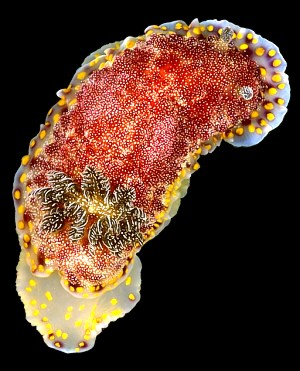
Chromodoris sp. 10
Order: NUDIBRANCHIA
Suborder: DORIDINA
Superfamily: EUDORIDOIDEA
Family: Chromodorididae
DISTRIBUTION
Tropical southeastern Pacific.
PHOTO
Byron Bay, northern New South Wales, March 1988, C155756. PHOTO: Bill Rudman.
This species of Chromodoris, belonging to the C. tinctoria colour group, is probably unnamed. Known from New Caledonia, Papua New Guinea and tropical eastern Australia, it grows to a large size for a chromodorid.
Authorship detailsRudman, W.B., 2000 (January 19) Chromodoris sp. 10 [In] Sea Slug Forum. Australian Museum, Sydney. Available from http://www.seaslugforum.net/find/chrosp10
Related messages
Chromodoris sp. 10 from Heron Island
August 4, 2000
From: Julie Marshall
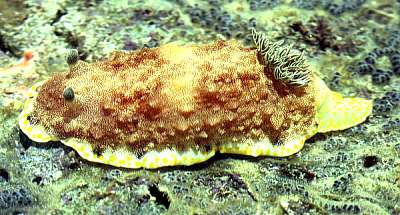

Dear Bill,
Some more photos of Chromodoris sp. 10 (Chromodoris sp. 2 in Richard and my book ) following the ones sent by Atsushi Ono last week. The raised yellow spots and violent blotches can be clearly seen in the photo showing the ventral side of the animal. It was 75 mm in size and found on the northern side of Heron Reef [Great Barrier Reef, Quensland] at 18 metres on a dead coral slab near a large bommie.
Best wishes
Julie Marshall
j.marshall@latrobe.edu.au
Marshall, J., 2000 (Aug 4) Chromodoris sp. 10 from Heron Island. [Message in] Sea Slug Forum. Australian Museum, Sydney. Available from http://www.seaslugforum.net/find/2818Thanks Julie,
Bill Rudman.
Chromodoris from Kerama Ids
July 24, 2000
From: Atsushi Ono
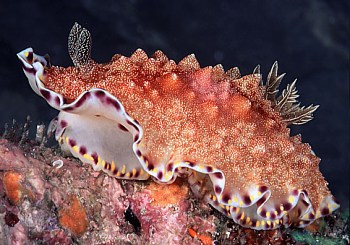
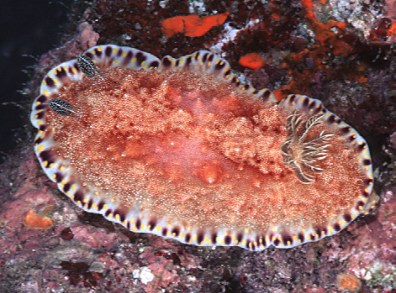
Dear Bill,
I found a strange chromodorid. It is similar to Chromodoris tinctoria, but there are purple and yellow spots on the inside edge of a mantle and foot.
At Kerama Is. near Okinawa in Japan.
10m depth on rock.
June, 2000.
About 60mm long.
Is this C. tinctoria?
Sincerely,
Atsushi Ono
ononini@cosmos.ne.jp
Ono, A., 2000 (Jul 24) Chromodoris from Kerama Ids. [Message in] Sea Slug Forum. Australian Museum, Sydney. Available from http://www.seaslugforum.net/find/2743Dear Atsushi,
Foe some years I have been building up anatomical information on the different 'species' with a 'tinctoria-like colour pattern. While most show no anatomical differences, there are a few, like this one that are clearly distinct. I have some other photos of this species on the Forum as Chromodoris sp. 10.
Best wishes,
Bill Rudman.
Chromodoris from Papua New Guinea
January 20, 2000
From: Mary Jane Adams
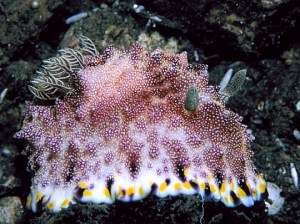

Hi Bill,
Can you identify this nudibranch? It was about 2 cm. long. I found it at 12 meters on a silty sand slope in Milne Bay Province, Papua New Guinea on March 1, 1999.
Thanks!
Mary Jane Adams
mjadams@earthlink.net
Adams, M.J., 2000 (Jan 20) Chromodoris from Papua New Guinea. [Message in] Sea Slug Forum. Australian Museum, Sydney. Available from http://www.seaslugforum.net/find/1751Dear Mary Jane,
I think this is an at present unnamed species of Chromodoris. It is very similar in colour to the various colour forms of Chromodoris tinctoria.
Since I have been studying chromodorids for many years, why haven't I already named it? It's quite a good example of how most taxonomists work these days. It is very tempting to pick all the 'easy' new species and rush out and name them all, as though naming new species is some sort of race or competition. Unless there is some overriding reason for a once-off name, such as sorting out a nomenclatural problem with an important or common species, most responsible taxomomists these days describe new species in the context of broader reviews, so new species can be compared and justified. Like most taxonomists, I have a filing cabinet full of drawings and notes on species I dissected years ago but have put aside until further information on related species becomes available.
This species of yours is a good example. i have known of it for about 20 years. There are many names in the scientific literature for animals with a similar colour pattern to your species. By gradually building up records and seeing photos and specimens from throughout the Indo-West Pacific, I am now pretty sure most refer to Chromodoris tinctoria but there are one or two which are still problematic and could refer to the species in your photo. So when I refer to a photo that appears in the Forum as an unnamed species it doesn't mean that it is unknown to science, it often means we are still 'working on it'.
Best wishes,
Bill Rudman.
